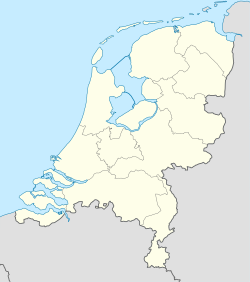Burcht van Leiden
| Burcht van Leiden | |
|---|---|
| Leiden, the Netherlands | |
 Burcht van Leiden (shell keep) | |
| Site information | |
| Type | Castle |
| Open to the public | Yes |
| Condition | Good |
| Location | |
| Coordinates | 52°9′32″N 4°29′32″E / 52.15889°N 4.49222°E |
| Site history | |
| Built | 1100 |
The Burcht van Leiden (Dutch pronunciation:
History

Originally built by Halewijn I in 1060. He was subsequently appointed viscount of Leiden by Count Dirk V of Holland. From humble beginnings, the hill was raised during various periods of history up to 9 m (30 ft) above the surrounding landscape in the 11th century.
Later in the 13th century the building was considered antiquated, since more and more townspeople and houses were built around the base of the hill, making defenses impossible without destroying most of the city. The old "interior keep" that had been built against the interior walls (a similar rounded keep construction can still be seen in Teylingen) was slowly dismantled and reused for city construction.
Symbol of Leiden

As the city of Leiden grew around it in the 13th and 14th centuries, the ruined castle lost its military function. The location became a romantic patriotic symbol after the
Public park
In 1651 the city bought the premises to make it into a water tower for public use. A system of waterpipes leading to squares in the city is still intact.[1] In this period a new portal on the keep wall was designed in 1662 with heraldric symbols by Rombout Verhulst, denoting the leading families of the city.[3][4] There are two other gates to the Burcht, one at the base of the hill with wrought iron heraldric weapons, built in 1653, and one on the south side of the complex, which itself forms a gateway to the park. In this Southern gateway a poem in Latin was used for centuries to teach the rudiments of grammar to Leiden students. A memorial plaque was placed in 1999 with the modern translation in Dutch.[5]
-
The Burcht in a 1698 print byFrederick de Witfor his atlas
-
Inside the Burcht, taken from the promenade around the ramparts that offer a panoramic view of the city.
-
Portal in the keep wall at the top of the steps, by Verhulst, 1658.
-
Iron gate at base of the hill, 1653
-
View towards the southeast from the top of the steps, showing the Hooglandse Kerk in the distance, and the back of the wrought iron gate and the Herenlogement in the foreground.
See also
Notes
References
- ^ a b Dutch Rijksmonumenten site 35904 (see also north of that gate Archis: monumentnr 3069)
- ^ Zsuzsanna van Ruyven-Zeman, Xander van Eck and Henny van Dolder-de Wit, Het geheim van Gouda: de cartons van de Goudse glazen, Zutphen (Walburg Pers) 2002.
- ^ Text on the information board at the base of the hill
- ^ Print by J.C. Philips in 1792 after a print in 1742
- ^ Zelfspraak van den Burg, plaque next to the gate with a translation of the Latin text (itself a timeline of events up to 1651), placed by the Leiden student club Quintus in 1999.






